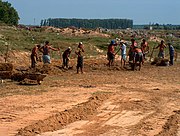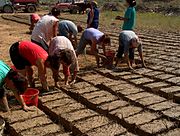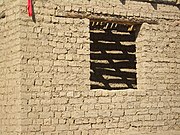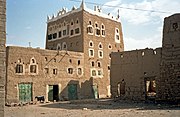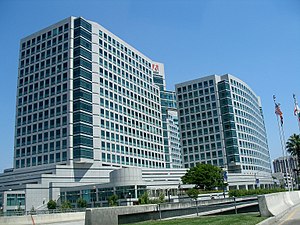Adobe Systems
From Wikipedia, the free encyclopedia
Adobe Systems
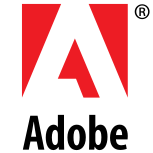 |
| |
| |
|---|
| |
|---|
| |
|---|
| |
|---|
| |
|---|
| |
|---|
| |
|---|
| |
|---|
| |
|---|
| |
|---|
| |
|---|
| |
|---|
| |
|---|
| |
|---|
| |
|---|
Adobe Systems Incorporated (
NASDAQ:
ADBE) (
 /əˈdoʊbiː/ ə-doh-bee
/əˈdoʊbiː/ ə-doh-bee) is an American computer software company founded in 1982 and headquartered in
San Jose, California, United States. The company has historically focused upon the creation of multimedia and creativity software products, with a more-recent foray towards
rich Internet application software development.
Adobe was founded in December 1982
[2] by
John Warnock and
Charles Geschke, who established the company after leaving
Xerox PARC in order to develop and sell the
PostScript page description language. In 1985,
Apple Computer licensed PostScript for use in its
LaserWriter printers, which helped spark the
desktop publishing revolution. The company name
Adobe comes from
Adobe Creek in
Los Altos, California, which ran behind the house of one of the company's founders.
[2] Adobe acquired its former competitor,
Macromedia, in December 2005, which added newer software products and platforms such as
Coldfusion,
Dreamweaver,
Flash and
Flex to its product portfolio.
As of 2010, Adobe Systems has 9,117 employees,
[2] about 40% of whom work in San Jose. Adobe also has major development operations in
Orlando,
Seattle, San Francisco,
Orem,
Minneapolis,
Waltham,
San Luis Obispo in United States;
Ottawa, Canada;
Hamburg, Germany;
Noida,
Bengaluru, India;
Bucharest, Romania; Beijing, China.
[edit] History
Adobe's first products after
PostScript were digital
fonts, which they released in a proprietary format called
Type 1.
Apple subsequently developed a competing standard,
TrueType, which provided full scalability and precise control of the
pixel pattern created by the font's outlines, and licensed it to
Microsoft. Adobe responded by publishing the
Type 1 specification and releasing
Adobe Type Manager, software that allowed
WYSIWYG scaling of
Type 1 fonts on screen, like
TrueType, although without the precise pixel-level control. But these moves were too late to stop the rise of
TrueType. Although
Type 1 remained the standard in the graphics/publishing market,
TrueType became the standard for business and the average Windows user. In 1996, Adobe and Microsoft announced the
OpenType font format, and in 2003 Adobe completed converting its Type 1 font library to
OpenType. Adobe's corporate logo was designed by Marva Warnock, wife of John Warnock, who is also a graphic designer.
[3]
In the mid-1980s, Adobe entered the consumer
software market with
Adobe Illustrator, a
vector-based drawing program for the
Apple Macintosh. Illustrator, which grew from the firm's in-house font-development software, helped popularize PostScript-enabled laser printers. Unlike
MacDraw, then the standard Macintosh vector drawing program, Illustrator described shapes with more flexible
Bézier curves, providing unprecedented accuracy. Font rendering in Illustrator, however, was left to the Macintosh's
QuickDraw libraries and would not be superseded by a PostScript-like approach until Adobe released Adobe Type Manager.
In 1989, Adobe introduced what was to become its
flagship product, a graphics editing program for the Macintosh called
Photoshop. Stable and full-featured, Photoshop 1.0 was ably marketed by Adobe and soon dominated the market.
[4]
In 1993, Adobe introduced
PDF, the Portable Document Format, and its
Adobe Acrobat and Reader software. PDF is now an International Standard:
ISO 32000-1:2008. The technology is adopted worldwide as a common medium for electronic documents.
Arguably, one of Adobe's few missteps on the Macintosh platform was their failure to develop their own
desktop publishing (DTP) program. Instead,
Aldus with
PageMaker in 1985 and
Quark with
QuarkXPress in 1987 gained early leads in the DTP market. Adobe was also slow to address the emerging
Windows DTP market. However, Adobe made great strides in that market with the release of
InDesign and its bundled
Creative Suite offering. In a failure to predict the direction of computing, Adobe released a complete version of Illustrator for
Steve Jobs' ill-fated
NeXT system, but a poorly-produced version for Windows.
Despite these missteps, licensing fees from the PostScript interpreter allowed Adobe to outlast or acquire many of its rivals in the late 1980s and early 1990s. In December 1991, Adobe released Adobe Premiere, which Adobe rebranded to
Adobe Premiere Pro in 2003. In 1994, Adobe acquired Aldus and added
Adobe PageMaker and
Adobe After Effects to its production line later in the year; it also controls the
TIFF file format. In 1995, Adobe added
Adobe FrameMaker, the long-document DTP application, to its production line after Adobe acquired Frame Technology Corp. In 1999, Adobe introduced
Adobe InCopy as a direct competitor to QuarkCopyDesk.
[5]
[edit] Company events
In 1992, Adobe acquired
OCR Systems, Inc.; in 1994, the company acquired
Aldus Corporation. On May 30, 1997, Adobe reincorporated in Delaware by merging with and into Adobe Systems (Delaware), which was incorporated on May 9, 1997. Adobe Systems Incorporated (Delaware) was the surviving corporation and changed its name to Adobe Systems Incorporated concurrently with the merger.
[6]
The company acquired GoLive Systems, Inc. and released
Adobe GoLive in 1999 and began shipping
Adobe InDesign as a direct competitor to
QuarkXPress and as an eventual replacement for
PageMaker. In May 2003, Adobe acquired Syntrillium Software, adding
Adobe Audition to its product line. In December 2004, French company OKYZ S.A., makers of 3D collaboration software, was acquired. This acquisition added 3D technology and expertise to the Adobe Intelligent Document Platform.
On December 12, 2005 Adobe acquired its main rival
Macromedia in a
stock swap valued at about $3.4 billion, adding
Adobe ColdFusion,
Adobe Contribute,
Adobe Captivate,
Adobe Acrobat Connect (formerly Macromedia Breeze),
Adobe Director,
Adobe Dreamweaver,
Adobe Fireworks,
Adobe Flash,
FlashPaper,
Adobe Flex,
Macromedia FreeHand,
Macromedia HomeSite,
Macromedia JRun, Adobe Presenter, and
Macromedia Authorware to Adobe's production line.
[7][8][9]
In January 2007,
Adobe Photoshop Lightroom was released to assist photographers in managing digital images and post production work. The product was intended as a competitor to
Apple's Aperture in the RAW image editing market. Adobe acquired
Scene7 in May of the same year. The company makes an image processing and display platform used in many retail sites on the web. In July, Adobe released
Soundbooth. This product was not intended to replace the existing
Adobe Audition but merely to provide an environment for professionals not specializing in audio. On August 3, 2007, the company announced their plans to discontinue development of
Authorware, the “visual authoring tool for creating rich-media e-learning applications for delivery on corporate networks, CD/DVD, and the Web.”
[10] Authorware was one of the development tools acquired in the Macromedia/Adobe merger. It was replaced by Adobe Captivate. In October, the company acquired Virtual Ubiquity, along with its online word processor,
Buzzword. On November 12, 2007, CEO,
Bruce Chizen resigned. Effective December 1, he was replaced by
Shantanu Narayen, Adobe's current president and Chief Operating Officer. Bruce Chizen served out his term on Adobe's Board of Directors, and then continued in a strategic advisory role until the end of Adobe's 2008
fiscal year.
Adobe released Adobe Media Player in April 2008. On April 27, Adobe discontinued development and sales of its older HTML/web development software,
GoLive in favor of
Dreamweaver. Adobe offered a discount on Dreamweaver for GoLive users and supports those who still use GoLive with online tutorials and migration assistance. On June 1, Adobe launched
Acrobat.com, a series of
web applications geared for collaborative work.
[11] Creative Suite 4, which includes Design, Web, Production Premium and Master Collection came out in October 2008 in six configurations at prices from about USD $1,700 to $2,500
[12] or by individual application.
[13] The Windows version of Photoshop includes 64-bit processing.
[13] On December 3, 2008, Adobe laid off 600 of its employees (8% of the worldwide staff) citing the
weak economic environment.
Adobe announced two acquisitions in 2009: on August 29, they purchased
Business Catalyst.,
[14] and on September 15, Adobe bought
Omniture.
[15] On November 10, the company laid off 680 employees.
[16] In 2010, Adobe announced it was investigating a "
coordinated attack" against corporate network systems in China, managed by the company.
[17] This same attack was also brought against
Google and over 20 other companies. Adobe announced the new Creative Suite series (CS5) launched globally Monday, April 12, 2010. New software such as
Flash Catalyst and
Business Catalyst were also announced.
Adobe's 2010 was marked by continuing back-and-forth arguments with Apple over the latter's non-support for Adobe Flash on its iPhone, iPad and other products.
[18] Apple CEO Steve Jobs has claimed that Flash is not reliable or secure enough, while Adobe executives have argued that Apple wish to maintain control over the iOS platform.
In January 2011, Adobe acquired Demdex, Inc with the intent of adding Demdex's audience-optimization software to its online marketing suite.
[19]
At PhotoShop World 2011, Adobe unveiled a new mobile photo service.
[20] Carousel is a new application for iPhone, iPad and Mac that uses Photoshop Lightroom technology for users to adjust and fine-tune images on all platforms.
[20] Carousel will also allow users to automatically sync, share and browse photos.
[20]
On November 9, 2011 Adobe confirmed that they had ceased development of Flash for mobile devices. Instead they will be focusing on HTML 5, due to it having wider support and greater capabilities than Flash.
[21]
On December 1, 2011, Adobe announced that it has entered into a definitive agreement to acquire privately held
Efficient Frontier, a leader in multi-channel ad buying and optimization.
[22][23]
[edit] Corporate leadership
[edit] Products
- Desktop software
- Adobe Photoshop, Adobe InDesign, Adobe Illustrator, Adobe Fireworks, Adobe Acrobat and Adobe Audition
- Server software
- Adobe ColdFusion, Adobe Content Server and Adobe LiveCycle Enterprise Suite
- Formats
- Portable Document Format (PDF), PDF's predecessor PostScript, ActionScript, Shockwave Flash (SWF) and Flash Video (FLV)
- Web-hosted services
- Adobe Kuler, Photoshop Express, and Acrobat.com
- Web design programs
- Adobe Dreamweaver, Adobe Contribute, Adobe Flash Builder, Adobe Flash Catalyst and Adobe Flash
- Video editing and visual effects
- Adobe Premiere Pro and Adobe After Effects
- eLearning software
- Adobe Captivate
- Organizational software
- Adobe Extension Manager and Adobe Bridge
[edit] Financial information
Adobe Systems entered
NASDAQ in 1986. Adobe's 2006 revenues were US$2.575 billion.
[25]
As of February 2007, Adobe's
market capitalization was roughly US$23 billion; as of August 2007, its shares were trading on the NASDAQ for around $40, with a P/E ratio of about 49 and EPS of about $0.82.
[25]
As of March 2008, Adobe's market capitalization was roughly $18 billion; its shares were trading on the NASDAQ for around $33, with a P/E ratio of about 27 and EPS of about $1.21.
[25]
As of April 2011, Adobe's market capitalization was roughly $17 billion; its shares were trading on the NASDAQ for around $33, with a P/E ratio of about 19.73 and EPS of about $1.70.
- ^ a b c d e f "2010 Form 10-K, Adobe Systems Incorporated". United States Securities and Exchange Commission.
- ^ a b c "Adobe Fast Facts" (PDF). 2009-03-09. Retrieved 2009-04-04.
- ^ "Adobe Logo: Design and History". Famouslogos.us. Retrieved 2011-07-28.
- ^ Hormby, Thomas. "How Adobe's Photoshop Was Born". SiliconUser. Retrieved 2007-06-12.
- ^ "About Adobe - Press Room - For Immediate Release". Adobe. Retrieved 2010-11-09.
- ^ "Adobe Investor Relations FAQ". Adobe. Retrieved 2010-06-29.
- ^ "Adobe to acquire Macromedia" (Press release). Adobe. 2005-04-18. Retrieved 2007-03-31.
- ^ "Adobe to Acquire Macromedia" (Press release). Macromedia. 2005-04-18. Retrieved 2007-03-31.
- ^ Graham, Jefferson (2005-04-18). "Adobe buys Macromedia in $3.4B deal". USA Today. Retrieved 2007-03-31.
- ^ "Authorware from Adobe : FAQ". Adobe. 2009-07-14. Retrieved 2010-05-30.
- ^ Larson, Erik (2008-06-01). "Welcome to Acrobat.com — Work. Together. Anywhere.". Adobe. Retrieved 2008-06-02.
- ^ "Adobe launches Creative Suite 4; Likely to top low expectations". ZDNet (CBS). September 23, 2008. Retrieved 2008-09-23.
- ^ a b Carlson, Jeff (September 23, 2008). "Adobe Announces Vast Creative Suite 4". TidBITS. Retrieved 2008-09-23.
- ^ "Adobe acquires Business Catalyst". Adobe. Retrieved 2010-05-29.
- ^ "Adobe to Acquire Omniture". Businesswire.com. 2009-09-15. Retrieved 2010-11-09.
- ^ Morrison, Scott (2009-11-10). "Adobe Will Cut 680 Jobs to Reduce Costs". Wall Street Journal. Retrieved 2010-11-09.
- ^ "Adobe Targeted by Cyber Attack from China". DailyTech. Retrieved 2010-05-29.
- ^ "Apple vs. Adobe". networkworld.com. 2010-06-07. Retrieved 2011-07-28.
- ^ "Adobe Acquires Demdex – Brings Audience Optimization to $109 Billion Global Online Ad Market". Adobe. 2011-01-18. Retrieved 2011-01-20.
- ^ a b c Darrell Etherington, GigaOm. "Adobe tries mobile photos as a service with Carousel." September 7, 2011. Retrieved September 12, 2011.
- ^ http://blogs.adobe.com/conversations/2011/11/flash-focus.html
- ^ ["http://www.skoolboyz.in/2011/12/adobe-to-acquire-efficient-frontier.html" "Adobe to Acquire Efficient Frontier, Leading Digital Ad Buying and Optimization Platform"]. Retrieved 1 December 2011.
- ^ "Adobe Buys Efficient Frontier to Boost Its Online Advertising Capabilities". Retrieved 1 December 2011.
- ^ http://www.adobe.com/aboutadobe/pressroom/pdfs/fastfacts.pdf
- ^ a b c "Adobe Systems Incorporated Company Profile". Google Finance.
- ^ "Adobe Reports First Billion Dollar Quarter" (PDF). Retrieved 2011-01-29.
- ^ "Q4 and FY2009 earnings press release" (PDF). Retrieved 2010-11-09.
- ^ "Q4 and FY2008 earnings press release" (PDF). Retrieved 2010-11-09.
- ^ untitled
- ^ "Q4 and FY2006 earnings press release" (PDF). Retrieved 2010-11-09.
- ^ "Q4 and FY2005 earnings press release" (PDF). Retrieved 2010-11-09.
- ^ "Q4 and FY2004 earnings press release" (PDF). Retrieved 2010-11-09.
- ^ "Q4 and FY2003 earnings press release" (PDF). Retrieved 2010-11-09.
- ^ "Q4 and FY2002 earnings press release" (PDF). Retrieved 2010-11-09.
- ^ "Press/Analyst Contacts" (PDF). Retrieved 2010-11-09.
- ^ "Q4 and FY2000 earnings press release" (PDF). Retrieved 2010-11-09.
- ^ "Adobe Systems Reports Record Revenue and Operating Profit for both Fourth Quarter and Fiscal Year 1999" (PDF). Retrieved 2010-11-09.
- ^ a b c d e "Adobe 4th Quarter Form 10-K" (PDF). Retrieved 2010-11-09.
- ^ "100 Best Companies to Work For 2009". CNN.
- ^ "Best Places to work in India".
- ^ "Reasons for Selection, 2009 Canada's Top 100 Employers Competition".
- ^ "Adobe responds to CS4 pricing criticism".
- ^ "Adobe defends CS4 pricing".
- ^ "Adobe responds to customer protests against perceived unfair pricing.".
- ^ "Adobe hikes UK prices by 10% | News".






